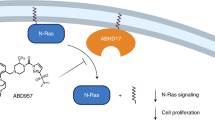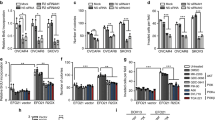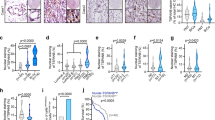Abstract
The IL-6-induced activation of the phosphatidylinositol-3′ kinase (PI3-K)/AKT cascade in multiple myeloma (MM) cells is critical for tumor cell proliferation and viability. Since the IL-6 receptor does not contain binding sites for the p85 regulatory portion of PI3-K, intermediate molecules must play a role. Coimmunoprecipitation studies in MM cell lines demonstrated the IL-6-induced formation of two independent PI3-K-containing complexes: one containing p21 RAS but not STAT-3 and a second containing STAT-3 but not RAS. Both complexes demonstrated IL-6-induced lipid kinase activity. IL-6 also generated kinase activity in a mutant p110 molecule that could not bind p85. Use of dominant-negative (DN) constructs confirmed the presence of two independent pathways of activation: a DN RAS prevented the IL-6-induced generation of lipid kinase activity in the mutant p110 molecule but had no effect on activity generated in the STAT-3-containing complex. In contrast, a DN p85 prevented the generation of kinase activity in the STAT-3-containing complex but had no effect on activity generated in the p110 molecule. Both DN constructs significantly prevented the IL-6-induced activation of AKT. MM cells expressing activating RAS mutations demonstrated enhanced IL-6-independent growth and constitutive PI3-K activity. These data indicate two potential independent pathways of PI3-K/AKT activation in MM cells: one mediated via signaling through RAS which is independent of p85 and a second mediated via p85 and due to a STAT-3-containing complex.
This is a preview of subscription content, access via your institution
Access options
Subscribe to this journal
Receive 50 print issues and online access
$259.00 per year
only $5.18 per issue
Buy this article
- Purchase on Springer Link
- Instant access to full article PDF
Prices may be subject to local taxes which are calculated during checkout







Similar content being viewed by others
References
Anderson K, Jones R, Morimoto C, Leavitt P and Barut B . (1989). Blood, 73, 1915–1922.
Billadeau D, Jelinek D, Shah N, LeBien T and Van Ness B . (1995). Cancer Res., 55, 3640–3646.
Boulton T, Stahl N and Yancopoulos GD . (1994). J. Biol. Chem., 269, 11648–11657.
Carpenter CL and Cantley LC . (1990). Biochemistry, 29, 11147–11156.
Catlett-Falcone R, Landowski T, Oshiro MM, Turkson J, Levitzki A, Savino R, Ciliberto G, Moscinski L, Fernandez-Luna JL, Nunez G, Dalton W and Jove R . (1999). Immunity, 10, 105–115.
Chen R-H, Chang M-C, Su Y-H, Tsai Y-T and Kuo M-L . (1999). J. Biol. Chem., 274, 23013–23019.
Franke T, Yang S-I, Chan TO, Datta K, Kazlauskas A, Morrison DK, Kaplan DR and Tsichlis PN . (1995). Cell, 81, 727–738.
Hakak Y, Hsu YS and Martin GS . (2000). Oncogene, 19, 3164–3171.
Hideshima T, Nakamura N, Chauhan D and Anderson K . (2001). Oncogene, 20, 5991–6000.
Hsu Jh, Shi Y, Hu L, Fisher M, Franke T and Lichtenstein A . (2002). Oncogene, 21, 1391–1400.
Hsu J-h, Shi Y, Krajewski S, Renner S, Fisher M, Reed JC, Franke T and Lichtenstein A . (2001). Blood, 98, 2853–2855.
Hu L, Shi Y, Hsu J-h, Gera J, Van Ness B and Lichtenstein A . (2003). Blood, 101, 3126–3135.
Kawano M, Hirano T, Matsuda T, Taga T, Horii Y, Iwato K, Asaoku H, Tang B, Tanabe O, Tanaka H, Kuramotot A and Kishimoto T . (1988). Nature, 332, 83–87.
Kishimoto T, Akira S, Narazaki M and Taga T . (1995). Blood, 86, 1243–1254.
Lee I-S, Liu Y, Narazaki M, Hibi M, Kishimoto T and Taga T . (1997). FEBS Lett., 401, 133–143.
Liu P, Leong T, Quam L, Billadeau D, Kay N, Greipp P, Kyle R, Oken M and Van Ness B . (1996). Blood, 88, 2699–2706.
Ogata A, Chauhan D, Urashima M, Teoh G, Hatziyanni M, Vidriales VMB, Schlossman R and Anderson K . (1997). J. Immunol., 159, 2212–2220.
Oh H, Fujio Y, Kunisada K, Hirota H, Matsui H, Kishimoto T and Yamauchi-Takihara K . (1998). J. Biol. Chem., 273, 9703–9710.
Panchamoorthy G, Fukazawa T, Miyake S, Soltoff S, Reedquist K, Druker B, Shoelson S, Cantley L and Band H . (1996). J. Biol. Chem., 271, 3187–3194.
Pfeffer LM, Mullersman JE, Pfeffer SR, Murti A and Yang CH . (1997). Science, 276, 1418–1425.
Podar K, Mostoslavsky G, Tai YT, Sattler M, Catley LP, Hideshima T, Chauhan D, Mulligan RC and Anderson KC . (2003). Hematol. J., 4, S140.
Podar K, Tai Y-T, Lin BK, Narsimhan RP, Sattler M, Kijima T, Salgia R, Gupta D, Chauhan D and Anderson KC . (2002). J. Biol. Chem., 277, 7875–7881.
Rodriguez-Viciana P, Warne PH, Vanhaesebroeck B, Gout I, Fry MJ, Waterfield MD and Downward J . (1994). Nature, 370, 527–532.
Rodriguez-Viciana P, Warne PH, Vanhaesebroeck B, Waterfield MD and Downward J . (1996). EMBO J., 15, 2442–2451.
Rowley M, Liu P and Van Ness B . (2000). Blood, 96, 3175–3180.
Sharma P, Egawa M, Huang Y, Martin JL, Huvar I, Boss GR and Olefsky J . (1998). J. Biol. Chem., 273, 18528–18530.
Shigematsu H, Iwasaki H, Otsuka T, Ohno Y, Arima Y and Niho Y . (1997). J. Biol. Chem., 272, 14334–14340.
Sjolander A, Yamamoto K, Huber BE and Lapetina EG . (1991). Proc. Natl. Acad. Sci. USA, 88, 7908–7912.
Tu Y, Gardner A and Lichtenstein A . (2000). Cancer Res., 60, 6763–6770.
Ueno H, Sasaki K, Honda H, Nakamoto T, Yamagata T, Miyagawa K, Mitani K, Yazaki Y and Hirai H . (1998). Blood, 91, 46–53.
Acknowledgements
We thank Dr Julian Downward, Imperial Cancer Research Fund, Dr Erich Gulbins, University of Tuebingen, Germany, Dr Hong-Gang Wang, University of South Florida and Dr Curt Horvath, Mt Sinai School of Medicine, for their generous gifts of plasmids. The parental ANBL-6 MM cell line and stable transfectants expressing mutated N-RAS or K-RAS genes were generous gifts from Dr Brian Van Ness, Minneapolis, MN, USA.
Author information
Authors and Affiliations
Corresponding author
Rights and permissions
About this article
Cite this article
Hsu, Jh., Shi, Y., Frost, P. et al. Interleukin-6 activates phosphoinositol-3′ kinase in multiple myeloma tumor cells by signaling through RAS-dependent and, separately, through p85-dependent pathways. Oncogene 23, 3368–3375 (2004). https://doi.org/10.1038/sj.onc.1207459
Received:
Revised:
Accepted:
Published:
Issue Date:
DOI: https://doi.org/10.1038/sj.onc.1207459
Keywords
This article is cited by
-
FBXO21 mediated degradation of p85α regulates proliferation and survival of acute myeloid leukemia
Leukemia (2023)
-
Targeting interleukin-6 as a strategy to overcome stroma-induced resistance to chemotherapy in gastric cancer
Molecular Cancer (2019)
-
The orally available multikinase inhibitor regorafenib (BAY 73-4506) in multiple myeloma
Annals of Hematology (2018)
-
Role of interleukin-6 in cancer progression and therapeutic resistance
Tumor Biology (2016)
-
Sorafenib, a dual Raf kinase/vascular endothelial growth factor receptor inhibitor has significant anti-myeloma activity and synergizes with common anti-myeloma drugs
Oncogene (2010)



